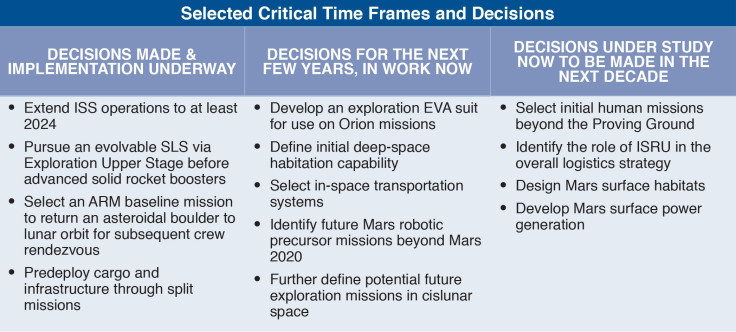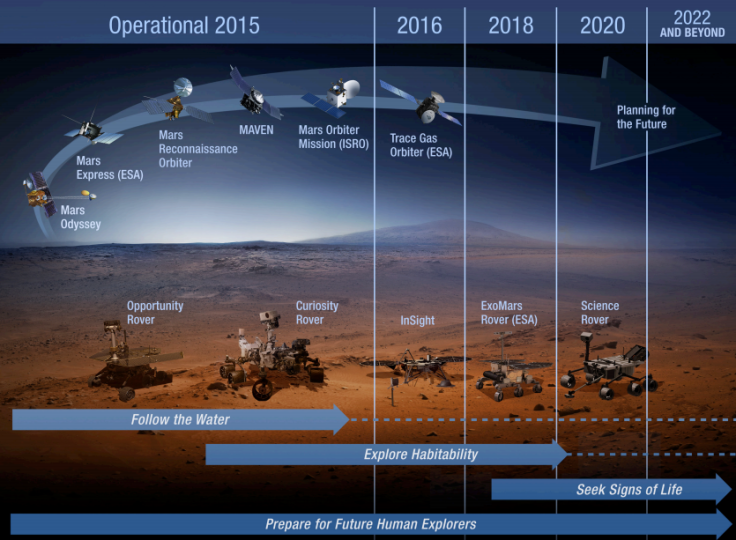NASA Mars Mission: Space Agency Unveils 3-Stage Plan To Send Astronauts To The Red Planet

Mars, despite its inhospitable climate and heavily irradiated surface that would kill humans in a matter of minutes, has been a source of unending fascination for scientists and science fiction writers alike. In recent years, this fascination has translated into concrete plans for a manned mission to the red planet, with the goal of eventually establishing an extraterrestrial colony.
In another step toward humanity’s journey to Mars, NASA on Thursday released a detailed outline of its plan to get to the red planet. Although the space agency did not announce a firm date for a manned mission, humans might be living and working in “Earth independent” habitats on Mars as early as the 2030s -- if all goes according to plan.
“NASA is closer to sending American astronauts to Mars than at any point in our history,” NASA Administrator Charles Bolden said in a statement accompanying the 36-page report. “In the coming weeks, I look forward to continuing to discuss the details of our plan with members of Congress, as well as our commercial and our international and partners.”

In its report, NASA lists three “thresholds” that need to be crossed before humans can reach Mars. The first stage of the plan -- which is already underway -- focuses on testing technologies and studying the impact of long-duration missions and microgravity on human health through experiments conducted aboard the International Space Station (ISS).
In the “Proving Ground” stage that follows, the space agency will not only conduct experiments and operations in the cislunar space -- the space around the moon -- it will also develop and test technologies required for human exploration of Mars. This includes a series of exploration missions -- starting with the first integrated test of the Space Launch System and the Orion spacecraft, tentatively scheduled to take place in 2018 -- and developing a reliable habitation system that can keep astronauts healthy and productive in the deep-space environment during missions that last up to 1,100 days.
The final stage would implement what NASA learns on the ISS and in deep space to enable human missions to the vicinity of Mars and possibly to low-Mars orbit or one of the Martian moons, and eventually the Martian surface.

“With humans on Mars, we will be able to advance science and technology in ways only dreamed of with current robotic explorers,” NASA said, in the report. “Future Mars missions will represent a collaborative effort among NASA and its partners -- a global achievement that marks a transition in humanity’s expansion as we go to Mars not just to visit, but to stay.”
NASA added that it is also committed to designing “a new and powerful transportation” system involving solar electric propulsion, which will use the sun’s energy to take spacecraft deeper into space.
“Focus areas include solar electric propulsion with advanced ion thrusters, habitation systems, nuclear fission for Mars surface power, EDL [Entry, Descent and Landing] systems, laser communications for high data rate transmission, deep-space atomic clocks for precise navigation, and many others,” the space agency said, in the report.

However, before manned missions to Mars become a reality, there are certain as-of-yet insurmountable problems that NASA would need to address. The average surface temperature on Mars is approximately minus 80 degrees Fahrenheit -- much lower than the human body can tolerate -- and since the planet’s atmosphere is 100 times thinner than Earth’s, astronauts would be subjected to relatively high levels of radiation both from the sun and from galactic cosmic rays.
“The journey to Mars will be further defined through Proving Ground missions in the next decade, as NASA and our partners retire these challenges and build on the capabilities for sustainable pioneering,” the report concludes. “We know these challenges are solvable and have a strategy in place for maturing the capabilities to address them as we expand human presence into deep space.”
© Copyright IBTimes 2024. All rights reserved.






















